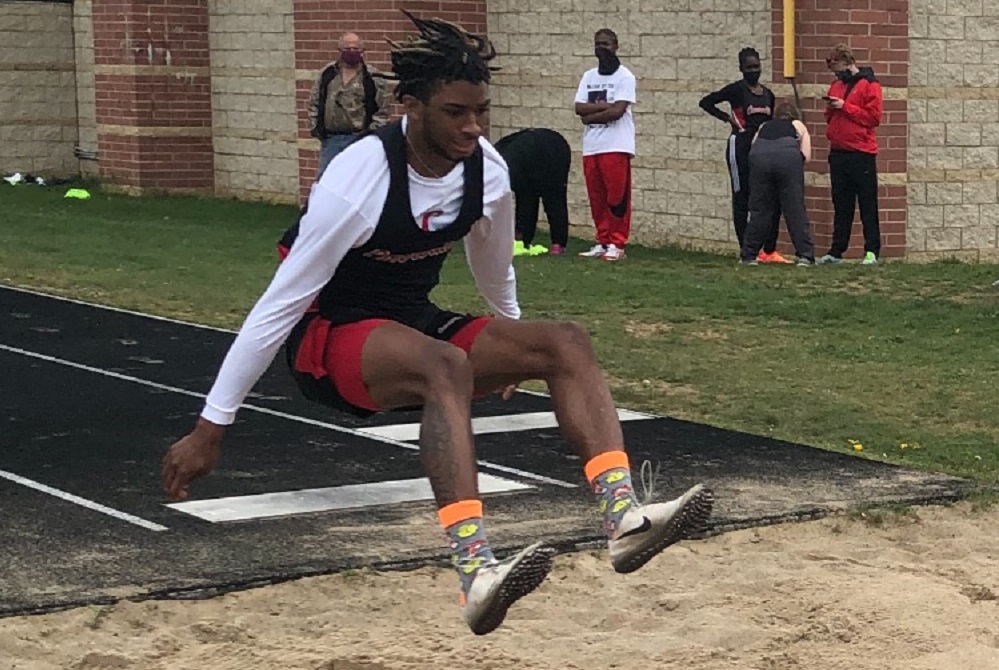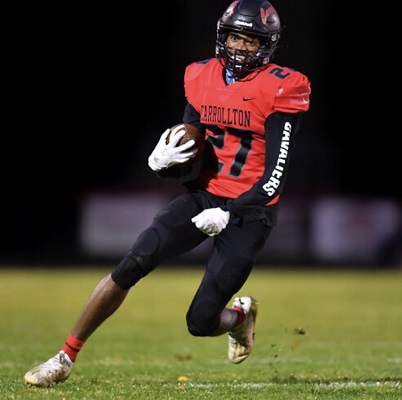
Carrollton's Voltz Making Big Leap in Long Jump
By
Paul Costanzo
Special for MHSAA.com
May 5, 2021
It makes sense that DJ Voltz excels at the long jump.
 The Carrollton junior is fast – he qualified for the Lower Peninsula Division 3 Finals in the 100 meters as a freshman. He’s also a multi-year all-state honoree in both football and basketball, a testament to his incredible athleticism.
The Carrollton junior is fast – he qualified for the Lower Peninsula Division 3 Finals in the 100 meters as a freshman. He’s also a multi-year all-state honoree in both football and basketball, a testament to his incredible athleticism.
How quickly he has exceled, though, is a little shocking.
Voltz’s jump of 22 feet, 2.5 inches, recorded April 30 at the Caro Tiger Invitational, is the state’s best early this season. He hit the mark in only his fifth time competing in the event.
“It’s really his first year doing it,” Carrollton track & field coach David Jaworski said. “He knew he wanted to long jump, and we knew with his speed and his athletic ability, it was something he could excel at. He’s a real competitive person. When he started, he was only able to hit (18 and 19 feet), but he’s been working with our jumpers coach, and one day he started hitting 20 and 21 consistently. It’s taken off from there.”
Extraordinary athletic achievement is nothing new for Voltz. He’s a star on the football field and the basketball court for the Cavaliers, having been named honorable mention all-state by The Associated Press in both sports as a sophomore and again as a junior in basketball, and second-team all-state as a junior in football.
His position listing for football was specialist, which, while accurate, also doesn’t seem to fully encapsulate Voltz’s role.
“He is kind of a jack of all trades,” said Jaworski, who is also Carrollton’s offensive coordinator. “We line him up at quarterback, running back, receiver, punt returner, kick returner. He played corner his first couple years, but this year we had a little more pressing needs, so he went back and played safety for us. He kind of plays where we need him to.”
 Football is king for Voltz, who plans to attend camps at Central Michigan and Grand Valley State among others this summer, and has a scholarship offer from Division II Gannon University in Florida.
Football is king for Voltz, who plans to attend camps at Central Michigan and Grand Valley State among others this summer, and has a scholarship offer from Division II Gannon University in Florida.
The 6-foot-3 speedster is being recruited as a cornerback at the next level, which would put him on the taller side of the position – the average NFL cornerback is just under 6 foot.
“They’ve been telling me when I get there, they like how I’m lanky and long,” Voltz said. “It’s easier for me to break up and intercept passes. I’m long and fast, and they said I’ve got quick feet, so I can stay with receivers.”
When asked what his position was on the basketball court, Voltz laughed before settling on combo guard. He averaged 17.5 points, 8.1 rebounds, 3.5 assists, 3.2 steals and 1.7 blocks this past season for a Carrollton team that was 13-5 and lost by one in the Regional Final.
“He doesn’t specialize in one thing,” Jaworski said. “He still goes and plays his AAU basketball tournaments. He has three or four football camps lined up early in June. He’s at track practice every day. He’s not one to miss things. He works tirelessly. He works with his own private trainer at times, and he’s also working hard at practice.”
That work ethic has quickly transformed Voltz from potential to production in the long jump, and there’s still room to grow.
“It’s all about the technique and how fast you’re running into it,” Voltz said. “You have to count your steps, make sure you jump and make sure you pick your feet up when you jump so you can have extra length in that sand pit. I still have a lot to learn. I really like doing long jump, and I’m getting the technique down. There’s always room to get better at it, and I’m trying to get even farther.”
The newfound success in the long jump has Voltz seriously considering adding track to his collegiate pursuits, and he said the football coaches he’s spoken with are on board with it.
For now, Voltz has his eyes on the school record, which at 23-2, he feels is attainable. He said he’s not thinking, yet, about potentially adding more all-state honors to his resume at the MHSAA Finals on June 5.
“It’s still early,” he said. “I’m still focusing on getting better for that situation. I’m not really focused on the later on, I’m focused on what’s going on right now.”
His focus and constant presence with Carrollton athletics is something Jaworski said is setting an example for younger athletes in the community. Voltz is more than happy to add mentor to his long list of duties.
“It means a lot,” he said. “I want to set an example, and when I leave this school, I want to be one of the ones they talk about – one of the greats at Carrollton. I want them to want to follow in my footsteps and want to be better than me. I want them to beat my records one day.”
 Paul Costanzo served as a sportswriter at The Port Huron Times Herald from 2006-15, including three years as lead sportswriter, and prior to that as sports editor at the Hillsdale Daily News from 2005-06. He can be reached at [email protected] with story ideas for Genesee, Lapeer, St. Clair, Sanilac, Huron, Tuscola, Saginaw, Bay, Arenac, Midland and Gladwin counties.
Paul Costanzo served as a sportswriter at The Port Huron Times Herald from 2006-15, including three years as lead sportswriter, and prior to that as sports editor at the Hillsdale Daily News from 2005-06. He can be reached at [email protected] with story ideas for Genesee, Lapeer, St. Clair, Sanilac, Huron, Tuscola, Saginaw, Bay, Arenac, Midland and Gladwin counties.
PHOTOS: (Top) Carrollton’s DJ Voltz soars through a long jump attempt this spring. (Middle) Voltz fills one of his many roles on the Cavaliers’ football team. (Photos courtesy of the Carrollton track & field program & DJ Voltz.)

Hastings Relays Reigns as State's Oldest Continuous Track & Field Meet
By
Steve Vedder
Special for MHSAA.com
April 10, 2024
Bob Branch remembers dabbling in other sports, but his first love was always running.
 The Hastings High School graduate admits he could never hit a baseball, football didn't especially appeal to him and basketball was just another way to spend time with friends. But for Branch, now 93, there was always track. That's the sport where his fondest and sharpest memories remain. And if you're talking track, many of his favorite memories come from participation in the state's oldest continuous track meet, the Hastings Relays.
The Hastings High School graduate admits he could never hit a baseball, football didn't especially appeal to him and basketball was just another way to spend time with friends. But for Branch, now 93, there was always track. That's the sport where his fondest and sharpest memories remain. And if you're talking track, many of his favorite memories come from participation in the state's oldest continuous track meet, the Hastings Relays.
Always held in early April, the meet dates back to 1937 – a bygone time that saw the first hostilities of World War II, gas at 20 cents a gallon and a loaf of bread selling for a dime.
And at a dusty old track surrounding the county fairgrounds in Hastings, a small relay event that included a scattering of participants from a dozen high schools was taking its first tentative steps.
Branch recalls a time when kids would run home after track practice because there were no buses, inexperienced young coaches had little actual knowledge of running fundamentals, and athletes looked at the sport as an afterthought after spending most of their high school days playing football and basketball.
 For Branch, the relays were the ideal way to ease into the track season.
For Branch, the relays were the ideal way to ease into the track season.
"I just liked to run," said Branch. "I remember I anchored a relay with my brother, and it always seemed cold when we had that meet. I remember teams would come from all over and you saw a lot of good athletes. Everybody seemed to have someone who was really good. Track wasn't very popular at that time, but I have a lot of good memories from running."
The Hastings Relays, which has changed formats and even names during its nearly nine-decade history, would traditionally kick off the track season. The meet was originally held at a makeshift quarter-mile track which surrounded the town's fairgrounds and was part of the city's annual Hastings Carnival – the track would become the midway during fair time.
The meet eventually moved to Johnson Field when the football field was dedicated in 1949 and ballooned to as many as 50 teams at its peak in 1957. For more than seven decades it was known as the Hastings Relays and then the Hastings Co-Ed relays before becoming the current Hastings Invitational, with the latest edition scheduled for Friday.
Johnson Field had a cinder track before it became an all-weather surface in the 1980s. During a time long before computers would be used to organize meet heats in mere minutes, Hastings coaches of all sports – defined as "volunteers" by the athletic department – would meet on the Friday before competition to hash out events.
People associated with the meet still recall the camaraderie built on those long Friday nights, followed by working what would often become 10-hour meets. Steve Hoke has been involved since watching his father, Jack, who coached teams at 15 of the meets beginning in 1951 and also had run in the first Hastings Relays. Steve Hoke later competed in the Relays as well during the early 1970s before becoming an assistant track coach, later the Hastings athletic director and now a volunteer worker.
"It was always a huge deal," said Hoke, who said the meet began as a pure relay event before transitioning to its current team format in the 1990s. "I remember we'd line the track the night before, and all the coaches would come to the house to organize everything. There was a brotherhood.”
 If you quiz many of the fleet of volunteers who've worked the relays over the years, each has a different memory from the meet. While Hoke describes the brotherhood and Branch the outstanding competition, others remember weather and the time a thunderstorm wiped out the line markings on the cinder track, or waking up to find three inches of snow that caused a rare cancellation of the meet. Others recall the shock of moving from the cinder to all-weather track or using the meet as an early measuring stick of what it would take to qualify for the state meet. The real old-timers remember the meet disappearing for three years during World War II.
If you quiz many of the fleet of volunteers who've worked the relays over the years, each has a different memory from the meet. While Hoke describes the brotherhood and Branch the outstanding competition, others remember weather and the time a thunderstorm wiped out the line markings on the cinder track, or waking up to find three inches of snow that caused a rare cancellation of the meet. Others recall the shock of moving from the cinder to all-weather track or using the meet as an early measuring stick of what it would take to qualify for the state meet. The real old-timers remember the meet disappearing for three years during World War II.
Hastings native and Western Michigan grad Tom Duits was the state’s second collegian to break the four-minute mile when he ran a 3:59.2 at a meet in Philadelphia in 1978. Duits, who ran in three Hastings Relays, was in line to join the U.S. Olympic team in 1980 before the United States pulled out of the games due to tension with Russia.
Duits has his own memories of the meet and the competition he faced there.
"I remember sunshine and being excited to be competing again. There were all these athletes swarming around; it was an awesome display of talent," he said. "It was always one of the best meets we'd be in. You could pretty much see the level of runners who would be at state, which made it a big deal. It was always early, but you could tell where you stood. It was great exposure."
Hastings track star Wayne Oom competed in four Hastings Relays from 1984-87. One of his sharpest memories was the difference between running on a raw cinder track versus the far more comfortable all-weather surface.
"Those cinders would grind into your skin," said Oom, part of the Hastings school record in the two-mile relay. "But I think it helped us because when we'd go to other tracks, it seemed we would run faster. I remember how competitive it was, especially in the distances. There were some great runners."
While participants have their unique memories, so do coaches. Former Saxons coach Paul Fulmer remembers 2008 when his team finished first on the boys side of the meet while his wife, Grand Haven coach Katie Kowalczyk-Fulmer, saw her girls team win the championship.
 "I knew we were one of the favorites to win because we were usually near the top of our conference and Regional," he said. "But then Katie's team was pretty good, and it was cool for them to win too."
"I knew we were one of the favorites to win because we were usually near the top of our conference and Regional," he said. "But then Katie's team was pretty good, and it was cool for them to win too."
Fulmer, who coached Hastings from 1978-81 and then 1985-2010, said at least part of the meet's popularity was derived from a unique way of scoring. Instead of individuals earning points solo, participants worked in pairs. For instance, two athletes would combine their shot put or long jump scores. New events such as the 1,500 relay and sprint medley were added.
"We had a tradition of being the state's oldest meet, and that was a big deal," Fulmer said. "And we ran a good relay; that attracted teams too. We took a lot of pride in that.
"And we'd get quite a lot of people to come to the meet. We'd set up until like 9 or 10 p.m., and then we'd have a party with all the coaches on Friday night."
While the meet has stretched 87 years, Branch said early participants and current runners have one thing in common: a drive to win. Branch ran in an era when the popularity of high school track was in its infancy. Today some of the best all-around athletes at a school are involved in the track program. The relays span the nearly nine decades in between.
"The quality of teams has gotten better and better," said Branch, the 1947 Lower Peninsula Class B Finals champ in the 220. "And this has made for a better meet. We would get guys who played football or baseball kind of drift into track, and that made the sport better. I think people began to appreciate track because we'd get teams from all over.
"We went from not really knowing what we were doing to track being a good sport. Even then, I'm not sure we appreciated what we had. We really liked the Hastings Relays and always wanted to do well there. It became popular and quite an honor to do well. Those are the kind of things I remember."
PHOTOS (Top) Racers run at the Hastings Relays, with several more awaiting their turns to compete at the longtime meet. (2) The author wrote on the 50th anniversary of the Relays for the Hastings Banner nearly 40 years ago. (3) Past athlete, coach and athletic director Steve Hoke shows some of the Relays awards from the 1930s. (4) Tom Duits was one of the state’s biggest track stars of the 1970s and ran in three Hastings Relays. (Top photo by Dan Goggins, Hoke photo provided by Steve Hoke and Duits photos provided by Tom Duits.)

